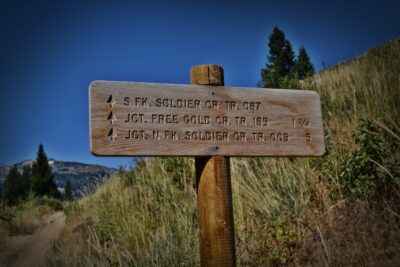
Part 2 of 3
By Karen Crowson

Editor’s Note: This is part 2 of 3 articles on the south Valley area known as Soldier. We left off as the little town was starting to bloom big. With booms, what often follows is bust. Enjoy!
Soldier’s progress didn’t make it immune to scandal. On June 17, 1895, the Wood River Times reported this juicy news:
“‘John Phillips shot and wounded W.Y. Perkins because of a disagreement over a card game at Soldier. Note: Phillips was arrested and tried in Hailey but the first jury disagreed 6-6. Nothing further is known but I think the case is dismissed. Perkins was a Soldier businessman, owning and operating W.Y. Perkins Hardware and W.Y. Perkins Flour Mill.”
There Flows The Neighborhood
The scuttlebutt didn’t stop the town from developing. On June 24, the Wood River Times noted that O.B. Sidell, an attorney from Denver, had taken over the Texas Star Mine on Soldier Mountain and would begin work in one week’s time with the intention of putting in a hoist and pump on the property so it could be thoroughly developed.
By 1896 there were three doctors’ offices in Soldier, doctors Purdy, Kingsley, and D. and Ayre Higgs, as well as a pool hall, a saloon, W.W. Leeks Meat Market, the Idaho Hotel, the Boyce Hotel, Dave Harness’s Livery Stable, Teen Harness’s Real Estate Office and Fix it Shop, and Bashford’s Warehouse.
During the last year of the 19th century, Soldier built its first jailhouse and welcomed to its community Methodist preacher W.W. Switzer, who had recently moved to the town. Reverend Bowler of the Baptist church shared the pulpit with Switzer.
Smallpox, Big Deals
The start of the 20th century in Soldier began with fearful and uneasy times. In 1900, Soldier’s population was reported to be 340, and at the start of the new year, a smallpox epidemic struck the town. By the middle of January, the town of Soldier was quarantined.
The epidemic sparked a revival among the churches in town when Rev. Mr. Bowler, Rev. Switzer and Rev. Helman conducted services. The church was full nightly, the paper reported. When the services were over, the crowd would go to the dance hall and dance until morning.
Misfortune struck Soldier again on Feb. 7, when the Boyce Hotel and Saloon of John Finch were consumed by fire. The reported loss for the Boyce Hotel and Saloon was $3,000 and for the Finch Saloon about $1,000. A shortage of carpenters pushed the rebuild of the properties into spring.
Even with the smallpox epidemic, by April, residents William G. Gulliford and Mary Gulliford were able to sell 171 acres of land near Soldier for $600 to Leo Spangler. Later that month, A.C. Floyd took ill and Larry Bannon took over the stage route between Hailey and the Camas Prairie. By May, things seemed to be turning around for the town of Soldier when a much larger version of the hotel was opened. Developers also erected a saloon at Soldier by mid-August, when the Boyce Hotel held a dance in honor of its resurrection. And so, Soldier continued on.
Changing Times
The flour mill did not continue. On Oct. 13, the Wood River Times announced that 11 farmers, each with a four- or six-horse outfit, arrived from Camas Prairie to haul away the two carloads of machinery for the flouring mill at Soldier.
“It looked like a circus had come to town,” the paper said.
And by the end of November, the flouring mill began to struggle with making its payouts competitive. In Hailey, farmers could receive roughly 33 percent more for their product.
Shortly after, D.P. Higgs took and passed the examination for a teacher’s certificate and became the first teacher of the first high school in Soldier.
In December, the town lost a matriarch when Sarah Severe Phillips passed away. It made history on the Camas Prairie as it was the first Mormon funeral that took place there. The corpse was interred in the Soldier Cemetery.
In 1902, Rev. Switzer was able to leave the Baptist church on the east side of town where he had been sharing the pulpit with Rev. Bowler, and began preaching at the newly built Methodist church on the west side of town. By 1906, the town got its second editorial publication with the inception of The Camas County Courier. Editors were McCaw, Baird, D.H. Guinn and Edgerton.
Soldier also introduced Settlers Day to the community, and in the following year, a Mr. and Mrs. Lowery Barkley moved to Soldier and opened up a drugstore on Main Street. By 1909, 15 years after the first weather station was installed at Soldier, the weather station was moved up Soldier Creek and became known as the Soldier Ranger Station.


